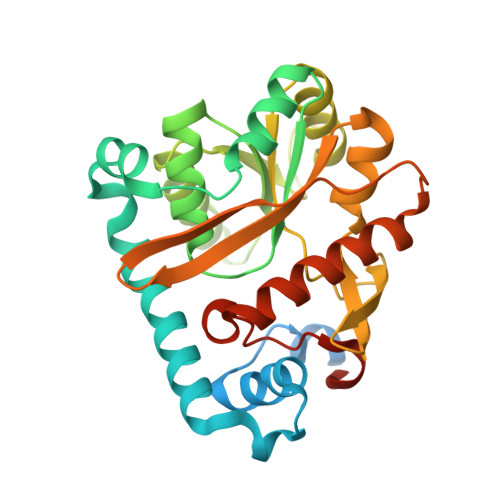The Molecular Mechanism of Substrate Recognition and Catalysis of the Membrane Acyltransferase PatA from Mycobacteria.
Tersa, M., Raich, L., Albesa-Jove, D., Trastoy, B., Prandi, J., Gilleron, M., Rovira, C., Guerin, M.E.(2018) ACS Chem Biol 13: 131-140
- PubMed: 29185694
- DOI: https://doi.org/10.1021/acschembio.7b00578
- Primary Citation of Related Structures:
5OCE - PubMed Abstract:
Glycolipids play a central role in a variety of important biological processes in all living organisms. PatA is a membrane acyltransferase involved in the biosynthesis of phosphatidyl-myo-inositol mannosides (PIMs), key structural elements, and virulence factors of Mycobacterium tuberculosis. PatA catalyzes the transfer of a palmitoyl moiety from palmitoyl-CoA to the 6-position of the mannose ring linked to the 2-position of inositol in PIM 1 /PIM 2 . We report here the crystal structure of PatA in the presence of 6-O-palmitoyl-α-d-mannopyranoside, unraveling the acceptor binding mechanism. The acceptor mannose ring localizes in a cavity at the end of a surface-exposed long groove where the active site is located, whereas the palmitate moiety accommodates into a hydrophobic pocket deeply buried in the α/β core of the protein. Both fatty acyl chains of the PIM 2 acceptor are essential for the reaction to take place, highlighting their critical role in the generation of a competent active site. By the use of combined structural and quantum-mechanics/molecular-mechanics (QM/MM) metadynamics, we unravel the catalytic mechanism of PatA at the atomic-electronic level. Our study provides a detailed structural rationale for a stepwise reaction, with the generation of a tetrahedral transition state for the rate-determining step. Finally, the crystal structure of PatA in the presence of β-d-mannopyranose and palmitate suggests an inhibitory mechanism for the enzyme, providing exciting possibilities for inhibitor design and the discovery of chemotherapeutic agents against this major human pathogen.
- Structural Biology Unit, CIC bioGUNE , Bizkaia Technology Park, 48160 Derio, Spain.
Organizational Affiliation:



















